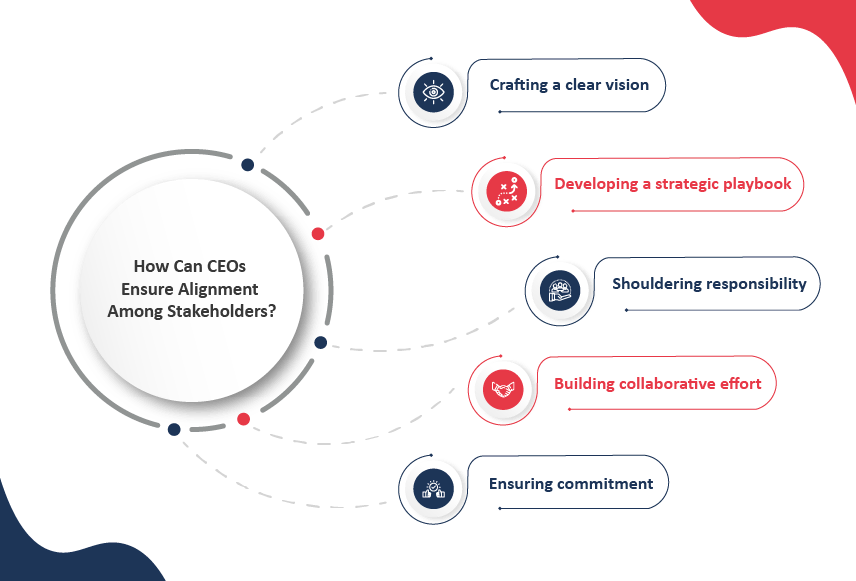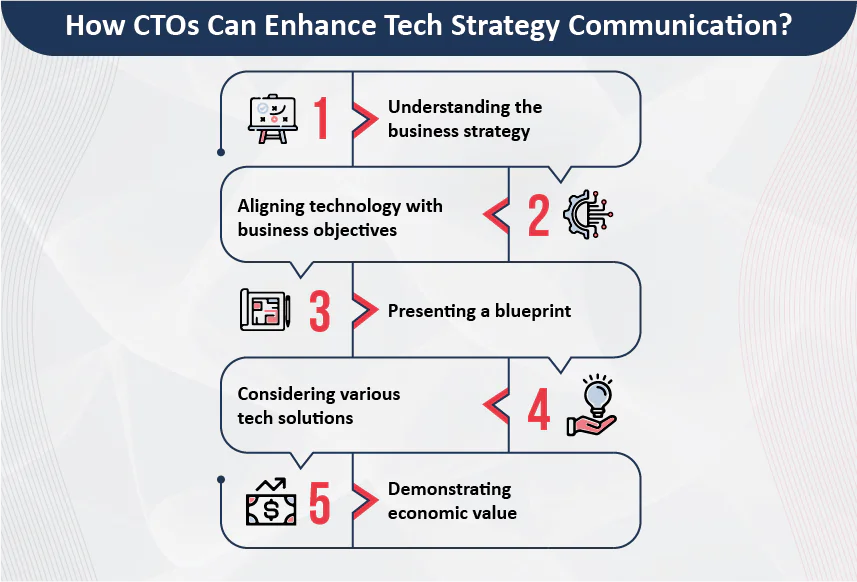
In today’s rapidly advancing digital landscape, navigating the intricate terrain of technology vision and strategy is paramount for success. For C-Suite executives, understanding and harnessing the power of technology is a strategic imperative. In the fast-paced business world, where the only constant is change, having a clear and robust technology vision and strategy is non-negotiable. It’s like having a compass that guides your organization toward innovation, competitiveness, and sustainable growth.
Efficient Communication Lies At The Heart Of Successful Technology Leadership. One Potent Tool In Achieving Alignment Is Developing And Utilizing A Common, Organic, And Strategic Vocabulary.
We understand that the stakes are high, and your decisions today will ripple through your organization’s destiny. Therefore, we’ll explore not only the ‘why’ but also the ‘how’ of crafting a technology vision and strategy that aligns with your overarching goals and propels your company toward the zenith of success. This blog is tailor-made to assist you in charting a course that integrates technology seamlessly into your business fabric.
We will delve deep into the art of envisioning a tech-driven future, outlining strategies that will enable you to adapt, thrive, and lead in this digitally charged era. So, fasten your seatbelts as we embark on a transformative journey through the realm of Technology Vision and Strategy, where insights blend seamlessly with technological foresight to shape your organization’s future.
Technology Vision and Strategy: The Price of Ineffective Communication
Technology leaders must work diligently to craft a technology vision and strategy roadmap that promises to propel your organization to new heights. However, having a brilliant plan is only half the battle won. You must communicate this vision and strategy effectively to your internal stakeholders to drive your organization toward technological excellence.
This statistic underscores the pressing need for tech leaders to formulate visionary plans and master the art of technology leadership communication.
After understanding the strategic synergy in tech communication within the sphere of leadership, it has become evident that failing in this critical aspect can have far-reaching consequences. Poor strategic communication can trigger a cascade of adverse effects that resonate throughout your organization, ultimately resulting in delayed success.
Harbinger recently launched a new webinar series called ‘The Tech CXO Roundtable’ in collaboration with WorkTech Advisory. The debut episode of this series was hosted by Dr. Vikas Joshi, Founder and CEO of Harbinger Group, and Marilyn Pearson Hendricks, Co-Founder and Managing Partner of WorkTech Advisory. Shrikant Pattathil, CTO of Harbinger Group, served as the emcee.
During this webinar, industry experts Apratim Purakayastha, Chief Product and Technology Officer at Skillsoft, and Larry Dunivan, Principal at Cefalo Group, discussed the important aspects of aligning a CTO’s technological vision with product strategy, which is a critical component of strategic planning.
Why is conveying the right business value to internal stakeholders so vital? The linchpin ensures everyone within your organization is aligned, motivated, and fully committed to the journey toward organizational success. Let’s delve deeper into the repercussions that poor strategic communication can usher in.
1. Misallocated Budgets
Inadequate communication of technology’s business value to internal stakeholders can lead to budgetary mismanagement. Projects may not receive the required funding, or resources might be allocated haphazardly, causing financial inefficiencies.
2. Escalating Technical Debt
When the technology vision and strategy are not effectively articulated, it can contribute to the accumulation of technical debt. Technical debt is incurred when shortcuts or suboptimal solutions are employed to meet immediate needs, compromising long-term stability.
3. Diminished Software Performance
Poor communication can result in misunderstandings and misalignments among development teams and stakeholders. This can lead to software development that does not meet performance expectations.
Subpar software performance can erode customer experience, damage your brand’s reputation, and ultimately affect your organization’s revenue and market standing. It also requires additional resources to rectify performance issues, diverting them from more strategic initiatives.
4. Soaring Variable Costs
Unclear communication can lead to uncertainty and fluctuations in project requirements and timelines. This uncertainty can increase variable costs, such as overtime pay and expedited resource allocation.
Elevated variable costs can strain your organization’s financial resources and diminish profitability. It can also lead to resource burnout and decreased morale among your team members.
By understanding these potential pitfalls, technology leaders can better appreciate the critical role that clear and comprehensive communication plays in achieving alignment between technology vision and strategy and ensuring the success of your organization.
What Role Does the CEO Play in Bringing Alignment with All Stakeholders?

In the complex and dynamic world of business, the CEO bears the unique responsibility of orchestrating alignment among stakeholders to drive an organization toward its goals. The CEO’s role is pivotal, from defining the ideal customer profile to shaping the business strategy.
1. Crafting a Clear Vision
The first step toward alignment is crafting a clear and compelling vision, particularly in identifying the ideal customer profile. As the top executive, the CEO sets the tone by articulating this vision. It serves as a North star for the entire organization, ensuring everyone is on the same page regarding the target audience and market.
2. Developing a Strategic Playbook
The CEO is not just a visionary but also a strategist. They must have a playbook that outlines how to approach the business. This playbook becomes a valuable resource, providing a structured framework for making crucial prioritization decisions. It ensures that the organization’s efforts are aligned with its overarching objectives.
3. Shouldering Responsibility
Ultimately, the CEO takes on the mantle of responsibility for making pivotal decisions that define the organization’s future. This includes determining the unique value proposition that sets the business apart in the market. It’s a challenging task that involves contemplating the business’s right to exist in the ever-evolving landscape.
4. Building Collaborative Effort
While the CEO plays a central role, achieving alignment is collaborative. The CEO has to facilitate drawing the boundaries of the organization’s focus. This involves defining the ideal customer and understanding the size of the market. It’s not just about the total addressable market but also about how well the organization can serve its target customers and grow profitably.
5. Ensuring Commitment
Commitment to the defined strategy is critical. It’s a task to be taken seriously and changed whimsically. CEOs who constantly alter their strategies can create chaos within the organization. Hence, the CEO must foster an unwavering commitment to the vision and strategy.
The CEO’s role in aligning stakeholders and shaping the organization’s strategic direction cannot be overstated. Through this alignment, organizations can navigate challenges, seize opportunities, and ultimately achieve success in a competitive business world.
Technology Vision and Strategy: Enhancing Strategic Communication for CTOs

Effectively conveying the technology vision and strategy to diverse stakeholders presents a formidable challenge. To surmount this hurdle and guarantee harmony between technology endeavors and business objectives, CTOs can embrace a strategic methodology. Let’s delve into how CTOs can enhance their communication in aligning technology with business goals:
1. Understanding the Business Strategy
The first step for a CTO is to grasp the organization’s business strategy comprehensively. With a deep understanding of the broader goals and priorities for the next few years, it’s easier to craft a technology strategy that aligns with and supports these objectives. Recognizing the company’s key strategic priorities is vital, as they provide the context for technological decisions.
2. Aligning Technology with Business Objectives
Once the business strategy is clear, the CTO must align the technology strategy with it. This alignment is essential for ensuring that technology initiatives complement and enable the achievement of strategic priorities. In essence, the technology strategy should serve as a bridge between the organization’s current state and where it aims to be in the future.
3. Presenting a Blueprint
To convey the alignment between technology vision and strategy effectively, CTOs can create a blueprint. This blueprint outlines the high-level technology solutions required to bridge the gap between the current and desired future states. It serves as a visual representation of how technology supports realizing strategic priorities.
4. Considering Various Tech Solutions
Not every solution needs to be built from scratch. CTOs should explicitly consider whether to build, partner, or combine both approaches. This decision should be based on various factors, including time to market, cost, practicality, and the organization’s core competencies. Being open to partnerships and integration can lead to more efficient and effective solutions.
5. Demonstrating Economic Value
Finally, CTOs should link the proposed technology vision and strategy to economic outcomes. This doesn’t require an extensive financial analysis but should be grounded in believable and credible terms. Consider the investment horizon and the expected return on investment, such as net new business acquisition or customer base growth. Relating ROI in technology initiatives to tangible economic benefits helps stakeholders understand the value of the proposed strategy.
How Common Strategic Vocabulary Foster Better Alignment?
Frameworks provide a structured approach to strategic tech decision-making and create a shared language that resonates with leaders and teams alike. The question arises: How does establishing a common strategic vocabulary contribute to better alignment?
CTOs and technology leaders often struggle with the divide between technology and business strategy. To ensure that their tech strategies align seamlessly with the organization’s broader goals, it becomes imperative to cultivate a shared vocabulary. This vocabulary serves as a common thread that weaves through discussions, ensuring everyone is on the same page.
Efficient Communication Lies At The Heart Of Successful Technology Leadership. One Potent Tool In Achieving Alignment Is Developing And Utilizing A Common, Organic, And Strategic Vocabulary.
The traditional terms of mission, vision, and values have frequently been used in isolation, resulting in a disconnect between strategy and execution. However, when these elements are effectively articulated and thoughtfully connected to a strategic framework, they take on a new dimension – stakeholder-centric tech leadership. This organic evolution of language ensures that discussions are substantive and meaningful, transcending buzzwords and jargon.
Furthermore, incorporating simple yet powerful questions like “What problem are you solving?” and “What are the key customer use cases?” can unify technology discussions. By anchoring conversations to real-world problems and customer needs, CTOs ensure that ROI in technology initiatives stay closely connected to the business’s core objectives.
Parting Thoughts
The ability to communicate a clear technology vision and strategy to internal stakeholders is indispensable. The path to technological excellence lies in communication, collaboration, and alignment. By mastering these principles, technology leaders can steer their organizations toward innovation, competitiveness, and ultimate success in a dynamic, ever-changing digital landscape.
Seeking guidance in articulating your technology vision and strategy to deliver business value to internal stakeholders? Reach out to our accomplished leaders at contact@harbingergroup.com today! Our seasoned experts are eager to assist you in charting the course to technological excellence and organizational expansion.





